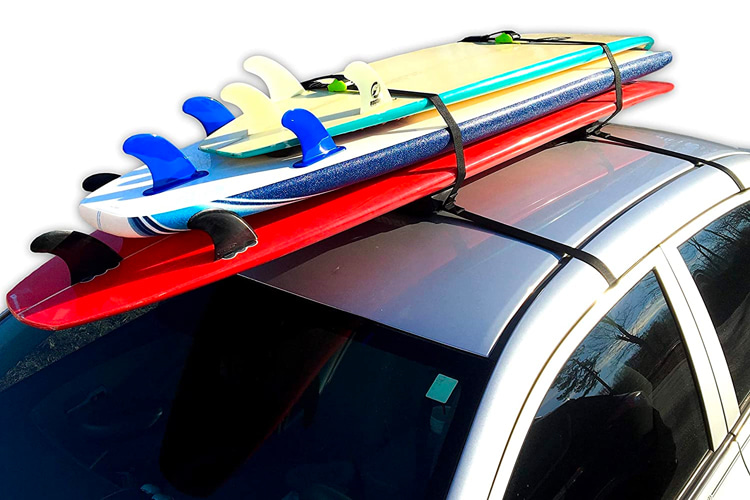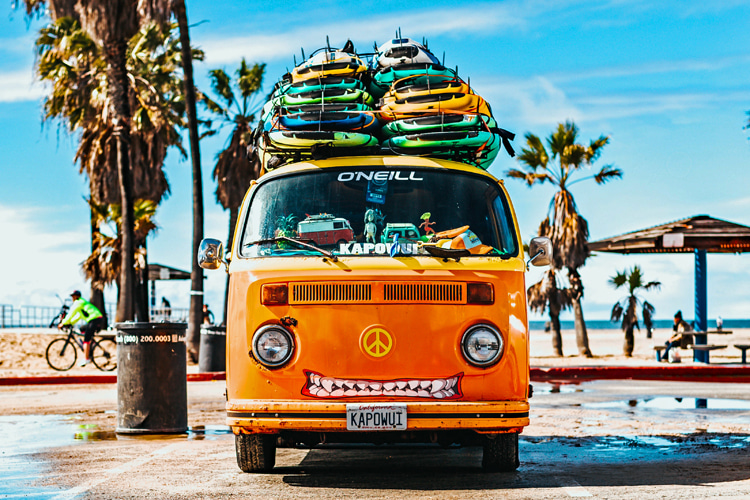Soft roof racks are handy, but it's critical that they're correctly installed on top of your car, and the surfboard is safely strapped. Here's how to do it.
Thanks to their neoprene/silicone buckle covers and pads with textured grip, your car and your board won't get scratched or dinged.
Also, the best soft racks for surfboards feature a textured grip on the pads' bottom so they won't slide around.
So, how do you get your surfboard to your surf spot if you don't live near the beach?
Whether you're about to start a surf trip or simply driving to your favorite surf break, there is always a comfortable way of carrying the surfboard.
If you're getting to the beach all by yourself, you can always place your shortboard in the passenger's seat or fold your back seats down, lay your board inside, and drive.
In this particular situation, you only need to use a board sock or travel bag so the wax doesn't melt all over your car's interior.
But if you're traveling with a friend or partner, with bigger boards, or your car is too small, you can't fold down the back seat,
And, for obvious reasons, it's never a good idea to take a surfboard inside the vehicle against the windshield.
Not only is it illegal, but it's always dangerous.
So, surfboard car racks are always the best and wisest option, and they only take about five minutes to install.
They're safe, won't occupy space inside the car, and will not reduce road visibility.
Furthermore, they allow you to carry up to three surfboards or more, and they work on any car, even if it's a two-door vehicle.
Padded roof racks are one of the most popular and helpful traveling items a surfer can get for their car and can be used with or without socks and bags on your surfboards.

Installing a Soft Roof Rack 101
Installing a universal soft car rack and tying down one or more surfboards securely on top of it is quick and easy. Here's a step-by-step guide:
- Open all four doors of your vehicle;
- Lay one pad above the front seats and the other above the rear seats on the car's roof, centering them between the driver's side and passenger side;
- Make sure the pads are straight and aligned and far enough apart for added surfboard stability;
- Wrap the straps through the vehicle's four doors and straighten them;
- Double-check to see there is no coiling or twisting of the straps;
- Push the heavy-duty metal buckle with your thumb and thread the straps through top-down;
- Pull the straps back away from the buckle and get them as tight as possible until the slack is gone;
- Adjust the position of the pads on top of your car while there is a bit of slack in the straps;
- Knot the very end against the buckle for extra security;
- Let that strap dangle inside your vehicle or tie it up near the roof of the car;
If you have a two-door car, the steps are the same.
All you need to do differently is place one pad as far forward as possible and the other as far back as you can over the front seat.
Because you won't be able to space the pads too far apart, this will only work with shortboards.
One thing to pay attention to at this stage is to check the pads' placement.
Ensure your pads are not too close together.
Otherwise, your board can teeter and wobble backward and forward once the car gets moving and the wind starts hitting the equipment.
If you have an antenna in the middle of your car roof, position the pads to either side.
Strapping a Surfboard to Car Racks 101
Now that the roof racks are correctly installed, it's time to strap the surfboard:
- Lay your surfboard on top of the soft pads with the deck side down and with the fins facing forward and up, i.e., with the tail in the front;
- Place the metal buckles in the center of the board;
- Slip the straps through the metal buckles bottom-up;
- Make sure the straps are flat and straight with no coiling going on;
- Knot the ends close to the metal buckle for extra security;
- Secure the loose ends inside the vehicle and close the doors so that they don't fly while driving;
- Pull on the boards to make sure they're secure;
- Pull all loose straps into the vehicle and close the doors;
If you hear a humming or vibrating sound while driving, it's probably a loose strap.
So, if that happens, make sure straps are all pulled inside the vehicle tightly, or try giving them a half/full twist before putting them through the buckle and tightening them.
If you're traveling with more than one board, remember to lay your longest board first, followed by the smaller ones.
A common mistake surfers make is to put the surfboard on top of the car with either the deck side up and/or fins in the back.
Having fins in the front and facing up will somehow block the board's upward movement.
In other words, if the board starts sliding out, the straps will catch the fins and may prevent the board from falling or flying away.
Also, remember not to put the outside roof straps into the clasp via the top side. Otherwise, if you pull them, they will come out quickly.
You've got to put them through the buckle bottom-up before tightening them as much as possible.
